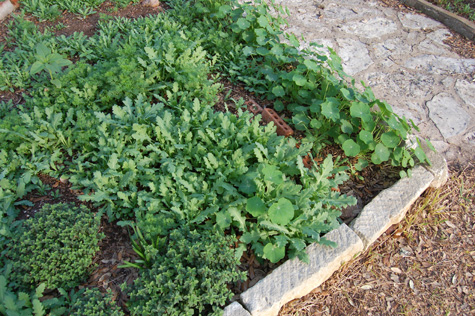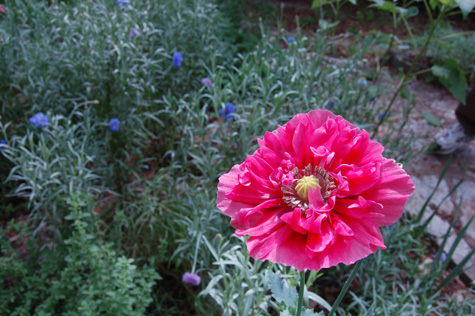Human Flower Project
Pro-Choice, Anti-Poppy-Thinning
The garden’s just getting going. Who has the heart to abort these zesty seedlings?

For those squeamish about thinning
Graphic: Human Flower Project
Call it passivity or – okay—laziness. How about “right-to-life”?
We find thinning flower seedlings one of the most wince-worthy tasks of early spring. When it comes to poppies, the duty borders on heartbreaking.
Take a look at our little cutting garden as of a couple of weeks ago. Nasturtiums are bobbling right along, there are a couple of volunteer sunflowers and freebie larkspur, three small mounds of oregano, and swarms of young “Dorothy poppies.”

February in the cutting garden: overcrowding or just urbane?
Photo: Human Flower Project
Since moving to Austin, we’ve grown this double, ruffly Shirley poppy passed along among gardeners here, and named for Dorothy Cavenaugh, who shared them liberally with her buddies in the Austin Herb Society.
We sow them the first week of November, after the annual compost pile tump. They seem to like this schedule almost as much as we do. Maybe exceedingly so. Because as much as we try sifting the previous year’s poppy seed with sand and broadcasting, the Dorothy seedlings sprout in these matted patches of green.

Shirley poppy (a.k.a. Dorothy poppy) with elbow room, 2007
Photo: Human Flower Project
Not good. Experience has proven that overcrowding makes for spindly plants and wimpy flowers, not like this jumbo beauty. (Here, we obviously failed to thin the cornflowers adequately – same timidity, different plant).
The first criterion for being a gardening expert must be RUTHLESSNESS. We read: “Seedlings need to be thinned out when their leaves begin to touch their neighbor.” After several rounds of thinning, we have lots of neighbor-touching going on.
This expert says to thin when plants “have sprouted their second set of leaves. This is called the true leaf stage, with the first set being the seed leaves. If they are left too long in an overcrowded tray, the top growth of each seedling will become lank and weak.”
Trouble is, our crowded poppies don’t look lank and weak, but hearty, as if all that touching were doing them good.
More cruel advice: “It’s very important to thin seedlings to a final spacing of 8-10” for tall poppies, 6-10”for CA poppies.” Eight to ten inches!!? We can’t even consider ripping out that many healthy plants. (And we’re not alone.)
With good advice from MSS of Zanthan Gardens, we tried some poppy transplantation last year, with so-so results. But that’s where we find ourselves again today – out with the iced tea spoon and watering can (MSS recommends transplanting just one or two at a time so they don’t wilt and watering the hole before settling in your displaced poppy.)

One of the unlucky sprouts, February 2009
Photo: Human Flower Project
As avidly pro-choice as we have always been in human affairs, it’s strange to feel so defensive about developing Papaver rhoeas. But there you have it. We were so careful last November, slowly sowing with a peppershaker and gently raking, hoping to avoid another crisis of conscience this spring. But despite our best plans and intentions, here we go aborting again.
We welcome advice from other scrupulous poppy gardeners about how to grow these and other tiny-seeded beauties more responsibly in the future.
Comments
I heart the logo. A talented graphic designer as well as writer.


I have a hard time with starting from seed for this very reason!
You have pulled them out so gently, could they possibly be replanted in loose soil, like in a neighbors yard?
they sure are coming up well!
(no neighbor touching….. this makes me laugh,
but now will always think of this line and seeds!)